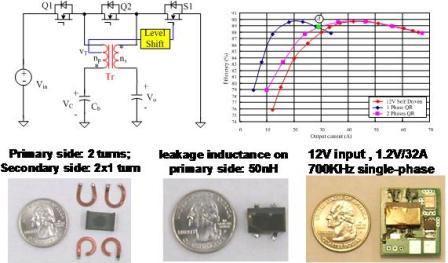Although aforementioned self-driven ZVS VR/VRM topology has demonstrated promising efficiency performance, it has to operate with two phases together at the same time, even under light load conditions. Comparing to the conventional buck wherein the operating-phase number can be shaded to one at light load, two-phase operation all the way down to no-load results in lower light-load efficiency. In addition, operation sensitivity to the leakage inductance of the transformer keeps it from being applied into the VR application where the discrete magnetics is required. Furthermore, the complicate structure always requires six devices and two drivers, regardless the power lever of the DC/DCs. This inflexibility reflects its another distinct drawback, especially for the low power application.
Therefore, a novel single-phase self-driven ZVS buck topology stems from the preceding self-driven ZVS full-bridge VR. It has the following advantages: 1) single-phase operation 2). Zero voltage switching of all switches. 3) Self-driven to eliminate SR drivers and save drive loss. 4) High efficiency, flexible, good dynamic performance, and low cost. The prototype below with discrete magnetic implementation has almost the same full-load efficiency as its precedent, while achieving much higher light-load efficiency by single-phase operation.























































































